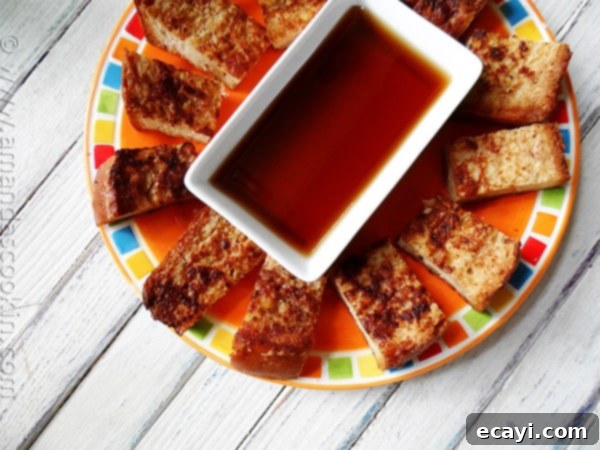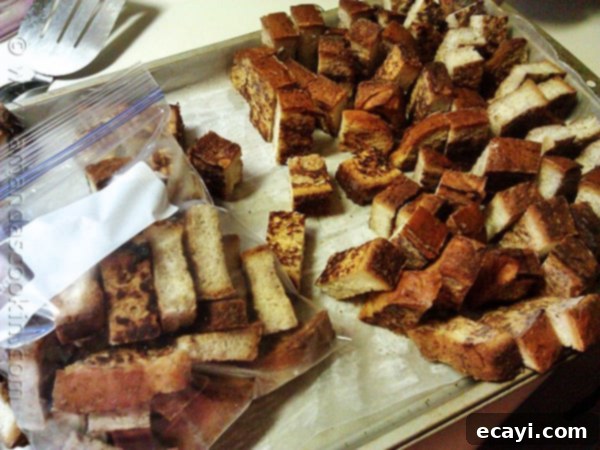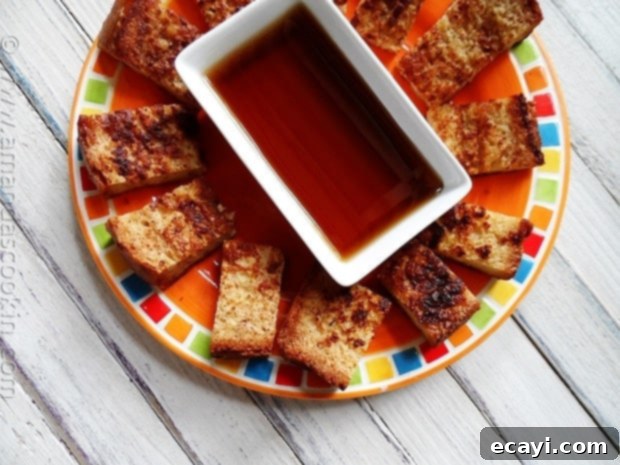Homemade Freezer French Toast Sticks: Your Ultimate Make-Ahead Breakfast Solution
In the whirlwind of busy mornings, a nutritious and warm breakfast often becomes the first casualty. For many families, breakfast before school or work defaults to a quick granola bar grabbed on the way out the door, or a half-eaten bowl of cold cereal. However, imagine a scenario where the promise of a warm, comforting breakfast can actually get everyone to the table, even on the most hectic days. That’s the magic of homemade freezer French toast sticks!
These delicious, individually frozen French toast sticks transform chaotic mornings into moments of delightful ease. They offer the perfect solution for both kids and adults who crave a satisfying start to their day without the usual fuss. A hot, wholesome breakfast isn’t just a treat; it’s a vital fuel source, boosting energy, focus, and overall well-being. By preparing a batch of these French toast sticks ahead of time, you’re not just saving minutes; you’re investing in a happier, more productive day for yourself and your loved ones. This comprehensive guide will walk you through everything you need to know about making, freezing, and reheating your very own batch of delectable French toast sticks.

Navigating the Morning Rush: Why a Good Breakfast is Essential
Life moves fast, and nowhere is that more apparent than in a household with active children and teenagers. My own kids are growing up at lightning speed: my youngest is 13 and entering eighth grade, my 15-year-old son is a high school sophomore, and my 18-year-old daughter is embarking on her first semester of college in just a few weeks. My oldest, now 20, is pursuing his career alongside his dad. It feels like just yesterday they were toddlers!
With busy schedules, school commitments, and burgeoning independence, teenagers often have a habit of skipping breakfast entirely. This is a habit I’m determined to combat, knowing how crucial a morning meal is for their concentration, mood, and overall health. A well-balanced breakfast provides the necessary glucose for brain function, helping them stay alert and perform better academically. It also contributes to better overall nutrition, helping them meet their daily vitamin and mineral needs, and can even help regulate weight by reducing overeating later in the day.
I’m always looking for creative, convenient ways to ensure my family is fueled for their day. Whether it’s having some homemade granola they can grab quickly, stocking the freezer with frozen pancake dippers, or these beloved freezer French toast sticks, I make it a priority. I’ve even taught them to whip up a portable scrambled egg in the microwave, which we affectionately call “muggies.” The thought of them leaving the house without eating drives me absolutely wild!
Of all the make-ahead breakfast options, French toast holds a special place in my family’s heart. When the freezer is stocked with these golden, sweet sticks, I know breakfast is guaranteed to be a hit. Recently, I’ve started baking extra loaves of my homemade white bread, which turns out to be absolutely perfect for making French toast. Its slightly denser texture holds up beautifully to the egg batter and freezing process, resulting in a superior texture compared to many store-bought breads, ensuring your homemade freezer French toast sticks are always a delight.

The Undeniable Advantages of DIY Freezer French Toast Sticks
Why go through the effort of making your own French toast sticks when you can easily buy them frozen from the grocery store? The answer lies in several key advantages that make the homemade version superior in every way:
- Unbeatable Taste and Quality: Homemade French toast simply tastes better. You control the freshness and quality of every ingredient, from the farm-fresh eggs and rich milk to the bread itself. This results in a French toast with a richer, more authentic flavor and a wonderfully satisfying texture that store-bought versions simply cannot match.
- Healthier Choices: Pre-packaged frozen French toast sticks often come loaded with preservatives, artificial flavors, high-fructose corn syrup, and excessive amounts of added sugar. By making them yourself, you have complete control over what goes into your family’s food. You can use whole, natural ingredients, adjust the sugar levels to your preference, and even opt for healthier bread choices like whole wheat or sprouted grain bread for added fiber and nutrients. This makes your freezer French toast sticks a genuinely wholesome option.
- Cost-Effective: Regularly purchasing pre-made frozen French toast can quickly add up. Making French toast from scratch is significantly more economical, especially if you take advantage of sales on eggs and milk, or use day-old bread, which is actually ideal for this recipe. This cost saving makes it a budget-friendly make-ahead breakfast solution.
- Customization to Perfection: From the type of bread you use to the spices in the batter, you can tailor your French toast to perfectly suit your family’s preferences. Want a hint of sweetness? Add more sugar or a touch of maple syrup to the batter. Craving an aromatic twist? A splash of vanilla extract, a pinch of nutmeg, or a hint of orange zest can elevate the flavor profile beautifully.
- Ultimate Convenience & Meal Prep: The “make-ahead” aspect is a true game-changer for busy households. Dedicate an hour or two on a relaxed weekend afternoon, and you can stock your freezer with a supply of ready-to-heat breakfast options that will last for weeks. This convenience transforms chaotic weekdays, making a warm, wholesome breakfast a quick and easy reality rather than a rushed compromise.
- Reduced Food Waste: Day-old bread that might otherwise go stale and be discarded finds a new, delicious purpose in this recipe, helping you minimize food waste and get the most out of your groceries.
Selecting the Ideal Bread for Freezer French Toast
The foundation of truly great French toast, especially when destined for the freezer, is undoubtedly the bread. While nearly any bread can technically be used, certain types elevate the experience significantly. For homemade freezer French toast sticks, I strongly recommend a good, sturdy loaf that can absorb the custardy batter without becoming overly soggy or falling apart. Crucially, bread that is a day or two old is actually preferable. Stale bread has less moisture, which allows it to soak up the egg mixture more effectively without turning mushy, ensuring a perfect texture even after freezing and reheating.
Here are some of the best bread options to consider for your DIY French toast:
- Homemade White Bread: As mentioned, my 1963 Homemade White Bread recipe is a fantastic choice. Its robust structure and slight chewiness are ideal for creating French toast that holds its shape and texture beautifully.
- Brioche: This rich, buttery French bread is a classic for a reason. Its high fat and egg content makes for an incredibly tender, sweet, and flavorful French toast with a golden crust. It’s wonderfully decadent.
- Challah: Similar to brioche, challah is an egg-rich Jewish braided bread that yields a beautifully golden, fluffy, and slightly sweet French toast. It’s another excellent choice for a luxurious breakfast.
- Texas Toast: These extra-thick slices are specifically designed to absorb a lot of liquid, making them perfect for a wonderfully custardy interior. Their thickness also means they stand up well to the freezing process.
- Sourdough: For those who prefer a less sweet breakfast or enjoy a delightful contrast of flavors, sourdough bread can be an excellent choice. Its slight tanginess pairs wonderfully with sweet syrup and fruit toppings.
- Cinnamon Swirl Bread: For an extra layer of flavor and sweetness, consider using a good quality cinnamon swirl bread. This adds a delightful spice element directly into the French toast.
A Note on Bread Freshness:
Regardless of the type, using bread that’s a day or two old is key. Fresh bread can absorb too much liquid too quickly and become mushy. If your bread is too fresh, you can lightly toast it in a dry skillet or toaster on a low setting, or simply leave it uncovered on the counter for a few hours to dry it out slightly before dipping. When cutting your bread for French toast sticks, aim for slices about 3/4 to 1 inch thick. This thickness ensures a good balance between the crispy exterior and the soft, custardy interior after cooking and reheating.
Crafting the Perfect French Toast: A Detailed Step-by-Step Guide
Making delicious French toast from scratch is a simple process, but a few key techniques will ensure you get the best results, especially when planning to freeze them for future enjoyment. Follow these steps for perfectly cooked homemade French toast:
1. Prepare the Flavorful Batter: Simple Yet Essential
The classic French toast batter is wonderfully straightforward, typically consisting of eggs, milk, sugar, and cinnamon. However, a few thoughtful additions can elevate it from good to absolutely outstanding:
- Vanilla Extract: A splash of good quality pure vanilla extract (about 1-2 teaspoons per batch) adds a lovely aromatic depth and warmth to the French toast.
- Nutmeg: A pinch of freshly grated nutmeg (or ground nutmeg) can warm up the flavor profile beautifully, especially when paired with cinnamon.
- Orange Zest: For a brighter, more complex and sophisticated flavor, a little finely grated orange zest (about 1 teaspoon) can be a wonderful and unexpected surprise.
In a medium to large shallow bowl or a pie plate (the wider surface makes it easier to dip the bread evenly), whisk together the eggs, milk, sugar, cinnamon, and any optional flavorings until thoroughly combined and slightly frothy. Ensure there are no streaks of egg white remaining.
2. Dipping the Bread: The Key to Texture
Once your batter is ready, it’s time to transform your chosen bread into golden, custardy French toast. The dipping process is crucial to achieve the right balance – you want the bread to absorb the flavor without becoming saturated and soggy.
- Don’t Rush the Dip: Quickly dip each slice of bread into the egg mixture. For thinner breads, a quick dunk of 5-10 seconds per side is often enough. For thicker slices like Texas Toast or brioche, you might allow it to soak for 15-20 seconds per side, ensuring it’s fully coated but not dripping.
- Allow Excess to Drip: Lift the bread from the batter and allow any excess liquid to drip back into the bowl for a few seconds. This prevents too much batter from accumulating in the pan and burning.
3. Cooking French Toast to Golden Perfection
Achieving that beautiful golden-brown crust and a fully cooked, custardy interior requires attention to heat and pan management:
- Preheat Your Skillet: Use a large, heavy-bottomed skillet or a non-stick griddle over medium heat. Allow it to heat up for a few minutes.
- Melt the Butter: Melt about 1/2 tablespoon of unsalted butter in the hot skillet for each batch. The butter not only adds flavor but also helps achieve a gorgeous golden crust. Ensure the butter is melted and coating the pan evenly.
- Cook in Batches: Place the dipped bread slices in the hot skillet, being careful not to overcrowd the pan. Give each slice some breathing room, as overcrowding can lower the pan temperature and lead to uneven cooking or steaming instead of frying.
- Cook Until Golden: Cook for about 3-4 minutes per side, or until each side is beautifully golden brown and the French toast is cooked through. The exact time will depend on your stove’s heat, the thickness of your bread, and how dark you prefer your crust. You want a firm, cooked interior, not raw batter.
- Repeat: Add another 1/2 tablespoon of butter to the skillet before frying each subsequent batch to prevent sticking and ensure every piece develops that desirable golden crust.
Once cooked, transfer the French toast directly to cooling racks if you plan to freeze them.

Freezing French Toast Sticks for Ultimate Convenience and Freshness
This is where the magic of make-ahead breakfast truly comes alive. Proper freezing techniques are essential to prevent sticking, freezer burn, and to maintain the quality and texture of your French toast. Following these steps ensures your freezer French toast sticks will be just as delicious as freshly made.
1. The Critical Cooling Step: Preventing Sogginess
After cooking, immediately transfer your French toast slices to wire cooling racks. This step is absolutely crucial and cannot be skipped. Allow them to cool completely to room temperature, which can take anywhere from 30 minutes to an hour, depending on your kitchen’s temperature and humidity. Using cooling racks allows air to circulate freely around all sides of the toast, preventing condensation and moisture from getting trapped. If you skip this step, trapped moisture will lead to ice crystals forming in the freezer, resulting in soggy French toast with an unpleasant texture when reheated.
2. Cutting and Flash Freezing: The Secret to No-Clump Storage
Once the French toast slices are thoroughly cooled and completely dry to the touch:
- Cut into Sticks: Use a sharp knife to cut each cooled French toast slice into bite-sized sticks (or “dippers”). This shape is not only fun for little hands to dip, but the smaller size also allows them to reheat more quickly and evenly than full slices.
- Prepare Your Baking Sheet: Line a large baking sheet (or multiple sheets, depending on the size of your batch) with waxed paper or parchment paper. This non-stick barrier is vital to prevent the French toast from sticking to the sheet during the freezing process.
- Arrange the Sticks: Lay the French toast sticks in a single layer on the prepared baking sheet. It is essential to ensure they are not touching each other. If space is limited, you can stand them up on their sides to fit more on the sheet, but again, make every effort to keep them from making contact. If they touch, they will freeze together and become one solid block.
- Flash Freeze: Place the entire baking sheet, with the spaced-out French toast sticks, into the freezer. Allow the French toast sticks to freeze completely solid. This typically takes 5-6 hours, or ideally, leave them overnight for best results. This “flash freezing” step is the secret to preventing them from clumping together when they are later transferred to storage bags. If you have a smaller freezer and cannot fit a large baking sheet, you can use plates or smaller freezer-safe containers that will fit, ensuring the sticks are still in a single layer.
3. Storage for Long-Term Freshness
Once the French toast sticks are frozen solid and individually hardened:
- Transfer to Freezer Bags: Carefully take the frozen sticks off the baking sheet and transfer them into heavy-duty zipper freezer bags or airtight freezer-safe containers. Because they were flash-frozen, they will remain separate and loose, allowing you to easily remove just the amount you need for a quick breakfast.
- Portioning for Convenience: For even greater convenience and excellent portion control, consider dividing the sticks into individual servings using smaller zipper sandwich bags or snack bags before placing these smaller bags into a larger freezer bag. This method is fantastic for kids to grab their own breakfast, helps reduce waste for those with “eyes bigger than their bellies,” and is perfect for adults to take to work for a quick, satisfying meal or snack. (A huge thank you to Angela from Big Bears Wife for that brilliant suggestion!).
- Label and Date: Always remember to label your bags or containers with the date and contents. Homemade freezer French toast sticks will maintain their best quality in the freezer for up to 3 months. While they are safe to eat after that, their taste and texture might start to degrade.
Reheating Your Frozen French Toast Sticks: Fast and Delicious
The true beauty of freezer French toast sticks lies in how quickly and effortlessly they can be reheated from their frozen state. While the microwave is the fastest method, other options offer varying levels of crispness to suit your preference. Here are the most effective reheating methods:
1. Microwave Method (Speed and Softness)
For ultimate speed and convenience, especially on frantic mornings, the microwave is your best friend:
- Place the desired number of frozen French toast sticks in a single layer on a microwave-safe plate. Avoid stacking them if possible, as this can lead to uneven heating.
- Heat at 100% (full) power for 1 minute.
- After 1 minute, check for doneness. If they are not heated through to your liking, continue heating in additional 15-second intervals until they are thoroughly warmed. Be careful not to overcook, as this can make them chewy.
2. Oven or Toaster Oven Method (For Crispiness)
If you prefer a crispier exterior and don’t mind a few extra minutes, the conventional oven or a toaster oven is an excellent choice. This method helps to re-crisp the edges that might soften in the freezer:
- Preheat your oven or toaster oven to 375°F (190°C).
- Arrange the frozen French toast sticks in a single layer on a baking sheet. You can line the baking sheet with parchment paper for easy cleanup.
- Bake for 8-12 minutes. For even heating and crispiness, flip the sticks halfway through the cooking time. Continue baking until they are heated through and lightly golden brown and crispy on the outside. Cooking time may vary based on your specific oven and the thickness of the sticks.
3. Air Fryer Method (For Super Crispy Results)
For the ultimate crispy French toast sticks, rivalling freshly fried ones, the air fryer delivers fantastic results. This method is quick and creates a wonderfully crunchy exterior:
- Preheat your air fryer to 350°F (175°C).
- Place the frozen French toast sticks in a single layer in the air fryer basket. It’s crucial not to overcrowd the basket, as air circulation is key for crispiness. Cook in batches if necessary.
- Cook for 5-8 minutes. Shake the basket halfway through the cooking time to ensure even browning and crispiness. Continue cooking until they are heated through, golden brown, and delightfully crispy.
Once reheated, serve your warmed frozen French toast sticks immediately with your favorite toppings – classic maple syrup, fresh berries, a dusting of powdered sugar, a dollop of whipped cream, or a side of crispy bacon or sausage for a complete breakfast! Enjoy the convenience of a hot, homemade meal on even the busiest of mornings.
Recipe for Classic French Toast

Classic Freezer-Friendly French Toast Sticks
IMPORTANT – There are often Frequently Asked Questions within the blog post that you may find helpful. Simply scroll back up to read them!
Print It
Pin It
Rate It
Save ItSaved!
Ingredients
- 6 large eggs
- 1 ½ cups milk 1%
- 2 tablespoons sugar
- 2 teaspoons ground cinnamon
- 12 slices of bread if homemade: cut into 3/4 inch slices (day-old bread works best)
- ¼ cup unsalted butter
Instructions
-
In a medium, shallow bowl (a pie plate works well), whisk together the eggs, milk, 2 tablespoons of sugar, and ground cinnamon until fully combined and slightly frothy. For enhanced flavor, consider adding 1-2 teaspoons of vanilla extract or a pinch of nutmeg.
-
Melt 1/2 tablespoon of unsalted butter in a large skillet or griddle over medium heat. Dip each slice of bread into the egg mixture, ensuring both sides are coated but not saturated. Allow any excess batter to drip off before placing it into the skillet.
-
Place the dipped bread slices in the hot skillet, being careful not to overcrowd. Cook until golden brown and cooked through, approximately 3-4 minutes per side.
-
Repeat with the remaining slices of bread, adding 1/2 tablespoon of butter to the skillet before frying each subsequent batch to ensure a beautiful golden crust and prevent sticking.
For Freezer-Friendly French Toast Sticks
-
Allow all cooked French toast slices to cool completely to room temperature on wire cooling racks. This crucial step prevents condensation and ice crystal formation during freezing, which can lead to soggy results. Ensure good air circulation around each slice.
-
Line a large baking sheet with waxed paper or parchment paper. Once the French toast slices are completely cooled, use a sharp knife to cut them into bite-sized sticks (or “dippers”). Arrange these pieces in a single layer on the prepared baking sheet, making sure they do not touch each other. This prevents them from freezing into a solid clump. If space is tight, you can stand them up on their sides. Place the baking sheet in the freezer and allow the sticks to freeze completely solid, which will take 5-6 hours or, ideally, overnight. This flash-freezing technique is essential.
-
Once thoroughly frozen, transfer the French toast sticks from the baking sheet into heavy-duty zipper freezer bags or airtight freezer-safe containers. For maximum convenience and portion control, consider dividing them into individual servings using smaller zipper sandwich bags before placing them all into a larger freezer bag. Label and date the bags, then store them in the freezer for up to 3 months.
To Reheat from Frozen
-
Microwave (for speed): Place the desired amount of frozen sticks in a single layer on a microwave-safe plate. Heat at 100% power for 1 minute. Check for doneness and continue heating in 15-second intervals if needed, until thoroughly warmed.
-
Oven or Toaster Oven (for crispiness): Preheat to 375°F (190°C). Arrange sticks in a single layer on a baking sheet. Bake for 8-12 minutes, flipping halfway through, until heated through and lightly crispy.
-
Air Fryer (for super crispy results): Preheat to 350°F (175°C). Place sticks in a single layer in the air fryer basket (do not overcrowd). Cook for 5-8 minutes, shaking the basket halfway, until golden and crispy.
Nutrition
The recipes on this blog are tested with a conventional gas oven and gas stovetop. It’s important to note that some ovens, especially as they age, can cook and bake inconsistently. Using an inexpensive oven thermometer can assure you that your oven is truly heating to the proper temperature. If you use a toaster oven or countertop oven, please keep in mind that they may not distribute heat the same as a conventional full sized oven and you may need to adjust your cooking/baking times. In the case of recipes made with a pressure cooker, air fryer, slow cooker, or other appliance, a link to the appliances we use is listed within each respective recipe. For baking recipes where measurements are given by weight, please note that results may not be the same if cups are used instead, and we can’t guarantee success with that method.
Frequently Asked Questions About Homemade Freezer French Toast Sticks
Q: How long do homemade French toast sticks last in the freezer?
A: When stored properly in airtight freezer bags or containers, homemade freezer French toast sticks can maintain their best quality for up to 3 months. Beyond that, they might gradually start to lose some flavor or develop freezer burn, though they would likely still be safe to eat.
Q: Can I use different types of bread for this recipe?
A: Absolutely! While a good quality white bread, brioche, or challah are excellent choices for their ability to absorb batter and maintain texture, you can certainly experiment with other sturdy breads like Texas toast, sourdough, or even cinnamon swirl bread for a different flavor profile. The most important factor is to ensure the slices are thick enough (3/4 to 1 inch) to hold up well to both the cooking and freezing process, and ideally, use day-old bread to prevent sogginess.
Q: How do I prevent my French toast sticks from becoming soggy after freezing?
A: The key to preventing sogginess is meticulous cooling and proper flash freezing. First, always cool your cooked French toast completely on a wire rack before cutting and freezing. This allows all steam to escape, preventing condensation from forming ice crystals. Second, ensure your bread isn’t too fresh; day-old bread is ideal as it absorbs the batter better without becoming overly saturated. During reheating, if you prefer crispiness, avoid over-microwaving, as this can make them soft; oven or air fryer reheating methods are best for a crispy exterior.
Q: Can I make these French toast sticks gluten-free or dairy-free?
A: Yes! This recipe is highly adaptable. For gluten-free French toast sticks, simply substitute the regular bread with your favorite sturdy gluten-free bread. For a dairy-free version, replace the cow’s milk with a non-dairy alternative such as almond milk, soy milk, oat milk, or cashew milk. The taste and texture will still be delicious and satisfying.
Q: What are the best toppings for French toast sticks?
A: The possibilities for toppings are endless and fun! Classic pure maple syrup is always a winning choice. Other popular options include a dusting of powdered sugar, fresh berries (strawberries, blueberries, raspberries), sliced bananas, a dollop of whipped cream, chocolate syrup, or a drizzle of honey. For a more indulgent treat, consider a spoonful of fruit compote, a sprinkle of mini chocolate chips, or even a dash of cinnamon sugar.
Conclusion: Your New Go-To Breakfast Solution
Making your own homemade freezer French toast sticks is more than just a recipe; it’s a smart and sustainable strategy for tackling busy mornings with ease and ensuring your family starts the day well-fed. From the satisfying golden crunch on the outside to the soft, custardy interior, these convenient breakfast bites are a wholesome, delicious, and budget-friendly alternative to store-bought options. They bring the comfort of a home-cooked meal right to your fingertips, even on the most hectic weekdays. So, next time you find yourself with a bit of extra time on the weekend, consider whipping up a big batch. Your future self, and your hungry family, will undoubtedly thank you for providing such a delightful and effortless breakfast solution!
